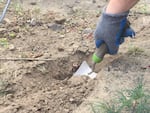
EarthFix reporters took soil samples from 30 properties and had them tested. Samples from 16 of those properties showed arsenic or lead above Washington’s cleanup threshold.
Courtney Flatt, NWPR/EarthFix
An area the size of Seattle and Portland combined is
likely contaminated from former orchard pesticide use in Washington.
More than 100 schools have been tested for such contamination, and over 50 had levels requiring cleanup. Independent researchers have tackled testing at child care centers, though the state has not. No one has carried out extensive testing on residential properties.
We wanted to see what they might find if they did.
Using a grant from the Fund for Environmental Journalism, EarthFix sampled and tested soil from 30 properties in Yakima and Wenatchee in Washington and Hood River in Oregon. These three areas were chosen for their histories of orchard production.
Individual properties were chosen at random. Neighborhoods were chosen based on where our reporting indicated orchards previously existed there.
Our goal was not to draw conclusions about the extent or pattern of contamination. We had neither the resources nor the expertise for that. We simply wanted to know if cursory sampling would reveal a contamination problem at homes where orchards used to be.
We also wanted to know whether property owners on former orchard lands were aware of the possible contamination.
Based on expert recommendations and guidelines from the Washington Department of Ecology, at least two samples were taken from each property: One from two inches deep and one from six inches deep. Where property owners granted permission for multiple sample locations, two additional samples were taken there.
Special Report
There's more in our report on legacy contamination on former orchards:
- Contaminated Soil Lingers Where Apples Once Grew
- Tips For Staying Safe Around Contaminated Soil
- How A Banned Chemical Helped Clean Up Washington's Orchards
- How Does Washington Clean Up Contaminated Soil? It Depends On Where You Live.
Trowels used for digging were washed and scrubbed after sampling to avoid cross-contamination.
Samples were kept in resealable zippered plastic bags. For testing, samples were sent to Innov-X, a Canadian company specializing in sampling equipment using X-ray fluorescence, a technology used to provide near-instantaneous results of metals and metalloids in soil. Innov-X was chosen because it supplies the Washington Department of Ecology with its screening equipment.
Innov-X returned a spreadsheet containing the amount of several elements, including lead and arsenic, listed as parts per million.
Of the 30 properties sampled, 16 contained samples showing arsenic or lead above Washington’s cleanup threshold. We found that just one resident was aware of potential lead arsenate contamination before we arrived.
Because of the small number of samples taken from each property, our findings likely underestimate the frequency and degree of contamination. Contamination from lead arsenate can have significant variation based on how and where spraying took place. Concentrations of more than 1,000 parts per million are known to exist in areas where the pesticides were stored or mixed.
Read the full story here.